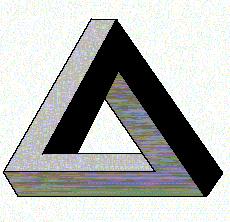
Here is some food for thought in Latin, Italian, Spanish and English . . . .

The paradoxical 2-dimensional/3dimensional image on the left is inspired by M.C. Escher. If you'd like to see more of his work you can check out another site on the World Wide Web.
Here are some notable passages which include religious views of the world (from the first millineum, A.D. and from the Middle Ages), voices of the Age of Discovery (Leonardo da Vinci and Christopher Columbus), and some more recent, secular expressions of Neil Armstrong and Michael ("Buzz") Aldrin, the first humans to walk on the moon. The first selection is the biblical description of the first five days of creation, from the Latin version of the Bible translated by S. Jerome (ca. 347-420 A.D) The the image of the Earth and the Moon next to the selection from Genesis was acquired by the Galileo spacecraft over 1500 years after St. Jerome translated the Bible into Latin,. The next selection is a medieval, religious poem written by St. Francis of Assisi (1228-1253 A.D.), entitled Cantico delle Creature. The picture of St. Francis preaching to the birds was painted by Giotto (1267-1337 A.D.). The third selection includes thoughts of Leonardo da Vinci (1452-1519 A.D.) who was forty years old when Columbus discovered America. His picture is a self-portrait. The next selection is a chronology of Christopher Columbus' life up to his first voyage to the Western Hemisphere, with links to passages from his navigational log which reveal some little-known details of the high-risk adventure and discovery of inhabitants of the Western Hemisphere by southern Europeans. The selection offering insights about the even-higher-risk exploration in which humans first set foot on the moon includes dialogue of Buzz Aldrin and President Nixon and a link to the web site of the National Aeronautics and Space Administration. The final selection of this food for thought is about exploration of the planet Saturn and includes a link to the official website of the Cassini Imaging Team.
These texts offer some insight into the evolution of languages derived from Latin, contrasts in low and high technology, contrasts in images from the middle ages to the twenty-first century, major discoveries, and religious beliefs which have played a significant part in history. Should the foreign languages prove daunting, turn to the World Wide Web where you can find sources of related information in the language of your choice.
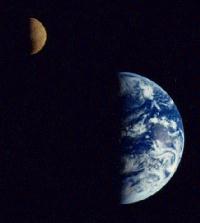 In principio creavit Deus caelum et terram. Terra autem erat inanis et vacua, et tenebrae erant super faciem abyssi, et Spiritus Dei ferebatur super aquas. Dixitque Deus: Fiat lux. Et facta est lux. Et vidit Deus lucem quod esset bona: et divisit lucem a tenebris. Appellavitque lucem Diem, et
tenebras Noctem: factumque est vespere et mane, dies unus. Dixit quoque Deus: Fiat firmamentum in medio aquarum: et dividat aquas ab aquis. Et fecit Deus firmamentum, divisitque aquas, quae erant sub firmamento, ab his, quae erant super firmamentum. Et factum est ita. Vocavitque Deus firmamentum, Caelum: et factum est vespere et mane, dies secundus. Dixit vero Deus: Congregentur aquae, quae sub caelo sunt, in locum unum: et apareat arida. Et factum est ita. Et vocavit Deus aridam Terram, congregationesque aquarum appellavit Maria. Et vidit Deus quod esset bonum. Et ait: Germinet terra herbam virentem, et facientem semen, et lignum pomiferum faciens fructum iuxta genus suum, cuius semen in semetipso sit super terram. Et factum est ita. Et protulit terra herbam virentem, et facientem semen iuxta genus suum, lignumque faciens fructum, et habens unumquodque sementem secundum speciem suam. Et vidit Deus quod esset bonum. Et factum est vespere et mane, dies tertius. Dixit autem Deus: Fiant luminaria in firmamento caeli, et dividant diem ac noctem, et sint in signa et tempora, et dies et annos; ut luceant in firmamento caeli, et illuminent terram. Et factum est ita. Fecitque Deus duo luninaria magna: luminare maius, ut praeeset diei: et luminare minus, ut praeeset nocti: et stellas. Et posuit eas in firmamento caeli, ut lucerent super terram et praeesent diei ac nocti, et dividerent lucem ac tenebras. Et vidit Deus quod esset bonum. Et factum est
vespere et mane, dies quartus. Dixit etiam Deus: Producant aquae reptile animae viventis, et volatile super terram sub firmamento caeli. Creavitque Deus cete grandia, et omnem animam viventem atque motabilem, quam produxerant aquae in species suas, et omne volatile secundum genus suum. Et vidit Deus quot esset bonum. Benedixitque eis, dicens: Crescite, et multiplicamini, et replete aquas maris: avesque multiplicentur super terram. Et factum est vespere et mane, dies quintus.
In principio creavit Deus caelum et terram. Terra autem erat inanis et vacua, et tenebrae erant super faciem abyssi, et Spiritus Dei ferebatur super aquas. Dixitque Deus: Fiat lux. Et facta est lux. Et vidit Deus lucem quod esset bona: et divisit lucem a tenebris. Appellavitque lucem Diem, et
tenebras Noctem: factumque est vespere et mane, dies unus. Dixit quoque Deus: Fiat firmamentum in medio aquarum: et dividat aquas ab aquis. Et fecit Deus firmamentum, divisitque aquas, quae erant sub firmamento, ab his, quae erant super firmamentum. Et factum est ita. Vocavitque Deus firmamentum, Caelum: et factum est vespere et mane, dies secundus. Dixit vero Deus: Congregentur aquae, quae sub caelo sunt, in locum unum: et apareat arida. Et factum est ita. Et vocavit Deus aridam Terram, congregationesque aquarum appellavit Maria. Et vidit Deus quod esset bonum. Et ait: Germinet terra herbam virentem, et facientem semen, et lignum pomiferum faciens fructum iuxta genus suum, cuius semen in semetipso sit super terram. Et factum est ita. Et protulit terra herbam virentem, et facientem semen iuxta genus suum, lignumque faciens fructum, et habens unumquodque sementem secundum speciem suam. Et vidit Deus quod esset bonum. Et factum est vespere et mane, dies tertius. Dixit autem Deus: Fiant luminaria in firmamento caeli, et dividant diem ac noctem, et sint in signa et tempora, et dies et annos; ut luceant in firmamento caeli, et illuminent terram. Et factum est ita. Fecitque Deus duo luninaria magna: luminare maius, ut praeeset diei: et luminare minus, ut praeeset nocti: et stellas. Et posuit eas in firmamento caeli, ut lucerent super terram et praeesent diei ac nocti, et dividerent lucem ac tenebras. Et vidit Deus quod esset bonum. Et factum est
vespere et mane, dies quartus. Dixit etiam Deus: Producant aquae reptile animae viventis, et volatile super terram sub firmamento caeli. Creavitque Deus cete grandia, et omnem animam viventem atque motabilem, quam produxerant aquae in species suas, et omne volatile secundum genus suum. Et vidit Deus quot esset bonum. Benedixitque eis, dicens: Crescite, et multiplicamini, et replete aquas maris: avesque multiplicentur super terram. Et factum est vespere et mane, dies quintus.
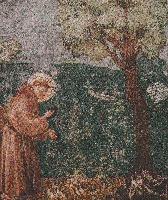 Altissimu, onnipotente, bon Signore, Tue so' le laude, la gloria, l'honore et onne benedictione.
Altissimu, onnipotente, bon Signore, Tue so' le laude, la gloria, l'honore et onne benedictione.
Ad te solo, Altissimo, se konfano et nullo homo ene dignu te mentovare.
Laudato sie, mi' Signore, cum tucte le tue creature, specialmente messer lo frate sole, lo quale iorno et
allumini noi per loi;
Et ellu è bellu e radiante cum grande splendore: de te, altissimo, porta significatione.
Laudato si', mi' Signore, per sora luna e le stelle; in celu l'ai formate clarite et pretiose et belle.
Laudato si', mi Signore, per frate vento, et per acre et nubilo et sereno et onne tempo, per lo quale a le tue creature dal sustentamento.
Laudato si', mi' Signor per sora aqua, la quale è molto utile et humile et pretiosa et casta.
Laudato si', mi' Signore, per frate focu, per lo quale enallumini la nocte; ed ello è bello et iocundo et robustoso et forte.
Laudato si', mi' Signore, per sora nostra matre terra, la quale ne sustenta et governa, et produce diversi fructi con coloriti fiori et herba.
Laudato si', mi' Signore, per quelli ke perdonano per lo tuo amore, et sotengo' infirmitate et tribulatione; beati quelli kel sosterranno in pace, ka da te, Altissimo, sirano incoronati.
Laudato si', mi' Signore, per sora nostra morte corporale, da la quale nulla homo vivente po skappare;
guai acquelli ke morrano ne le peccata mortali; beati quelli ke troverà ne le tue sanctissime voluntati, ka la morte secunda nol farrà male.
Laudato et benedicte mi' Signore, et rengratiate et serviateli cum grande humilitate.
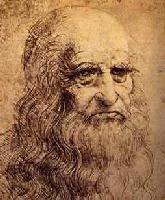 4. La natura è piena d'infinite ragioni che non furon mai in isperienza.
4. La natura è piena d'infinite ragioni che non furon mai in isperienza.
5. La scienzia è il capitano e la pratica sono i soldati.
8. DELLE SCIENZE. - Nessuna certezza è dove non si pò applicare una delle scienzie matematiche, ovver che non sono unite con esse matematiche.
10. DELL'ERROR DI QUELLI CHE USANO LA PRATICA SANZA SCIENZIA. - Quelli che s'innamoran di pratica sanza scienzia son come 'l nocchieri ch'entra in navilio sanza timone o bussola, che mai ha certezza dove si vada.
14. Nessun effetto è in natura senza ragione; intendi la ragione e non ti bisogna sperienzia.
31. Ogni nostra cognizione prencipia da sentimenti.
32. Ogni omo sempre si trova nel mezzo del mondo e sotto il mezzo del suo emisperio e sopra il centro d'esso mondo.
35. L'acqua che tocchi de'fiumi è l'ultima di quella che andò e la prima di quella che viene. Così il tempo presente.
45. Reprendi l'amico in segreto e laldalo in paleso.
91. Chi vol vedere come l'anima abita nel suo corpo, guardi come esso corpo usa la sua cotidiana abitazione; cioè se quella è sanza ordine e confusa, disordinato e confuso fia il corpo tenuto dalla su' anima.
108. Io d'ubbidisco, Signore, prima per l'amore che ragionevolmente portare ti debbo, secondariamente ché tu sai abbreviare o prolungare le vite a li omini.
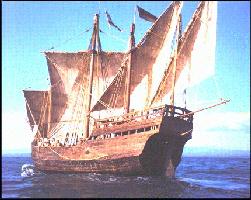 1451 Nacimiento de Isabel, futura reina de Castilla, en Madrigal de las Altas Torres, el 22 de abril. Nacimiento de Cristóbal Colón en Génova, entre el 25 de agosto y el 31 de octubre.
1451 Nacimiento de Isabel, futura reina de Castilla, en Madrigal de las Altas Torres, el 22 de abril. Nacimiento de Cristóbal Colón en Génova, entre el 25 de agosto y el 31 de octubre.
1474, 25 de julio Carta a Colón de Paolo Del Pozzo Toscanelli (1397-1482), astronomo florentino, que trata de la tesi de la rotundidad de la Tierra.
1476-79 Colón en Lisboa, ganándose la vida como cartógrafo y quizá como agente comercial. Visita también a Inglaterra, Madeira y Génova.
1480-81 Nacimiento de la Idea. Correspondencia con Toscanelli. Nacimiento del hijo de Colón, Diego, en Porto Santo. Muerte de Felipa, probablemente en un parto. España declara la guerra a Granada.
1482-84 Colón hace por lo menos dos viajes a Guinea. Plan presentado a Juan II de Portugal y rechazado por una Comisión Real. Colón se marcha a España con su hijo.
1484-85 Colón en la servidumbre del Duque de Medinaceli, de quien trate de obtener respaldo
financiero para su plan.
1486, 20 de enero Colón llega a Córdoba.
Mayo Plan presentado a Fernando e Isabel. Se nombra una comisión para que lo estudie.
1488-enero Colón escribe a Juan II de Portugal, ofreciéndole de nuevo sus servicios, pero pidiendo un salvoconducto para Portugal, done teme encontrarse con sus acreedores.
20 de marzo Recibida respuesta de Juan II con invitación y garantía de salvo conducto.
15 de agosto Nace en Córdoba el hijo de Colón, Fernando, de la amante de Colón,
Beatriz Enriquez de Harana.
diciembre Llegada a Lisboa de Bartolomé Diaz, después de dar la vuelta al cabo de Buena Esperanza.
1490 El plan de Colón rechazado por la Comisión Talavera. El hermano de Colón, Bartolomé, trata de conseguir apoyo en Inglaterra y Francia.
1492, 2 de enero Capitula Granada.
30 de marzo Todos los judíos no convertidos expulsados de España.
1492, 17 de abril Primer acuerdo de Colón con Fernando e Isabel.
12 de mayo Colón va a Palos.
2 de agosto Los últimos judíos abandonan España
3 de agosto La Santa María, la Pinta, y la Niña zarpan de Palos.
12 de agosto La Santa María y la Niña anclan en la Gomera.
25 de agosto La Santa María, y la Niña se reúnen con la Pinta en Gando, de Gran Canaria
1º de septiembre Las tres naves zarpan para la Gomera.
6 de septiembre Partida de Gomera. Comienza el viaje a través del océano. Rumbo al oeste.
7 de octubre Rumbo alterado al oessudoeste.
11 de octubre Seve una luz dos horas antes de medianoche.
12 de octubre San Salvador avistado al amanecer. Posteriormente, Colón desembarca y toma posesión de la isla para España."
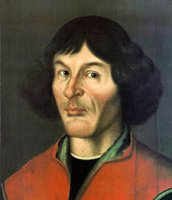
At Nuremberg in 1543, Nicolaus Copernicus published De revolutionibus orbium coelestium describing heliocentric theory as an alternative model to the geocentric, Ptolemaic system of the universe. The publication of this work is regarded by many as the starting point of modern astronomy and the approximate time at which the Scientific Revolution began. Copernicus was a polymath of the Renaissance, being a mathemetician, astronomer, physician, classical scholar, translator, Catholic cleric, jurist, governor, military leader, diplomat, and economist. ; Although others in Greece and India and some Muslims had had published heliocentric hypotheses before Copernicus, his publication stimulated further scientific investigation by other such as Tycho Brahe, who developed the Tychonic system describing the solar system, Johannes Kepler, and Galileo Galilei who having defended heliocentrism was imprisoned as a heretic by the Catholic Church. Later research in astronomy and physics by Isaac Newton and René Descartes also built upon the intellectual foundation of heliocentrism described by Copernicus in De revolutionnibus orbium coelestium.
The splashdown May 26, 1969, of Apollo 10 cleared the way for the first formal attempt at a manned lunar landing. Six days before, the Apollo 11 launch vehicle and spacecraft half crawled from the VAB and trundled at 0.9 mph to Pad 39-A. A successful countdown test ending on July 3 showed the readiness of machines, systems, and people. The next launch window (established by lighting conditions at the landing site on Mare Tranquillitatis) opened at 9:32 AM EDT on July 16, 1969. The crew for Apollo 11, all of whom had already flown in space during Gemini, had been intensively training as a team for many months.
Apogee: 186km
Perigee: 183km
Translunar injection: 02:44:26 MET
Maximum distance from Earth: 389,645km
Lunar orbit insertion: 75:50:00 MET
Lunar landing: 102:33:05 MET (20 July 1969 at 04:17 p.m. EDT)
First step on moon: 10:56:15 p.m. EDT
End of EVA: 111:39:13 MET (01:09 a.m. EDT)
Liftoff from moon: 124:22:00.8 MET (1:54 p.m. EDT)
LM-CSM docking: 128:03:00 MET
Transearth injection: 135:23:52.3 MET
First manned lunar landing mission and lunar surface EVA. "HOUSTON, TRANQUILITY BASE HERE.THE EAGLE HAS LANDED." July 20, Sea of Tranquility. 1 EVA of 02 hours, 31 minutes. Flag and instruments deployed; unveiled plaque on the LM descent stage with inscription: "Here Men From Planet Earth First Set Foot Upon the Moon. July 1969 A.D. We Came In Peace For All Mankind." Lunar surface stay time 21.6 hours;59.5 hours in lunar orbit, with 30 orbits. LM ascent stage left in lunar orbit. 20kg (44 lbs) of material gathered.
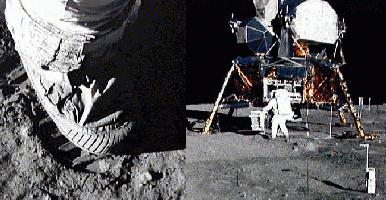 Astronaut Buzz Aldrin of the Apollo 11 Mission, having landed on the moon, speaks of President Nixon: "The President's voice smoothly fills the air waves with the unaccustomed cadence of the speechmaker, trained to convey inspiration, or at least emotion, instead of our usual diet of numbers and reminders. 'Neil and Buzz, I am talking to you by telephone from the Oval Office at the White House, and this certainly has to be the most historic telephone call ever made . . . Because of what you have done, the heavens have become a part of man's world. As you talk to us from the Sea of Tranquility, it inspires
us to redouble our efforts to bring peace and tranquility to Earth . . .' My God, I never thought of all this bringing peace and tranquility to anyone. As far as I am concerned, this voyage is fraught with hazards for the three of us-and especially two of us-and that is about as far as I have gotten in my thinking."
Astronaut Buzz Aldrin of the Apollo 11 Mission, having landed on the moon, speaks of President Nixon: "The President's voice smoothly fills the air waves with the unaccustomed cadence of the speechmaker, trained to convey inspiration, or at least emotion, instead of our usual diet of numbers and reminders. 'Neil and Buzz, I am talking to you by telephone from the Oval Office at the White House, and this certainly has to be the most historic telephone call ever made . . . Because of what you have done, the heavens have become a part of man's world. As you talk to us from the Sea of Tranquility, it inspires
us to redouble our efforts to bring peace and tranquility to Earth . . .' My God, I never thought of all this bringing peace and tranquility to anyone. As far as I am concerned, this voyage is fraught with hazards for the three of us-and especially two of us-and that is about as far as I have gotten in my thinking."
"[Fellow Astronaut] Neil [Armstrong], however, pauses long enough to give as well as he receives. 'It's a great honor and privilege for us to be here, representing not only the United States but men of peace of all nations, and with interest and a curiosity and a vision for the future.' [Later] Houston cuts off the White House and returns to business as usual, with a long string of numbers for me to copy for future use. My God, the juxtaposition of the incongruous- roll, pitch, and yaw; prayers, peace, and
tranquility. What will it be like if we really carry this off and return to Earth in one piece, with our boxes full of rocks and our heads full of new perspectives for the planet? I have a little time to ponder this as I zing off out of sight of the White House and the Earth."
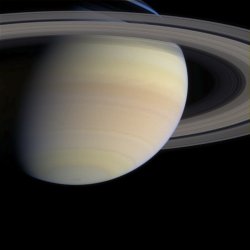
 Cassini, one of the most sophisticated planetary spacecraft ever built, was launched on October 15, 1997 from Cape Canaveral, Florida, USA. Its ultimate mission is a thorough, in-depth, 4-year-long exploration of the Saturn system--including the
planet, its moons, it rings, and the relationships between these heavenly bodies and other parts of the universe. This intense study of the Saturn system began in the summer of 2004 when Cassini arrived at
Saturn after a 7 year journey across the solar system. A vigorous spirit of discovery is evident as scientists from several nations explore the solar system using the Cassini spacecraft. Their research
is revealing aspects of our universe not even imagined for millennia of humankind's existence on Earth. One of the remarkable discoveries of the Cassini Imaging Team is an immense vortex with a well-developed eye ringed by towering clouds, a phenomenon never before observed on any other planet except Earth by humans. This vortex was sensed at Saturn's south pole by instruments of the Cassini spacecraft. For more information on the planet Saturn, including images of Saturn, its rings, Jupiter, Earth and moons of Saturn and Earth, visit the official website of the Cassini Imaging Team and home of the Cassini Imaging Central Laboratory for Operations.
Cassini, one of the most sophisticated planetary spacecraft ever built, was launched on October 15, 1997 from Cape Canaveral, Florida, USA. Its ultimate mission is a thorough, in-depth, 4-year-long exploration of the Saturn system--including the
planet, its moons, it rings, and the relationships between these heavenly bodies and other parts of the universe. This intense study of the Saturn system began in the summer of 2004 when Cassini arrived at
Saturn after a 7 year journey across the solar system. A vigorous spirit of discovery is evident as scientists from several nations explore the solar system using the Cassini spacecraft. Their research
is revealing aspects of our universe not even imagined for millennia of humankind's existence on Earth. One of the remarkable discoveries of the Cassini Imaging Team is an immense vortex with a well-developed eye ringed by towering clouds, a phenomenon never before observed on any other planet except Earth by humans. This vortex was sensed at Saturn's south pole by instruments of the Cassini spacecraft. For more information on the planet Saturn, including images of Saturn, its rings, Jupiter, Earth and moons of Saturn and Earth, visit the official website of the Cassini Imaging Team and home of the Cassini Imaging Central Laboratory for Operations.